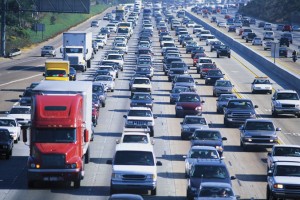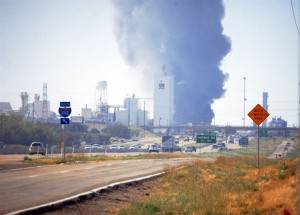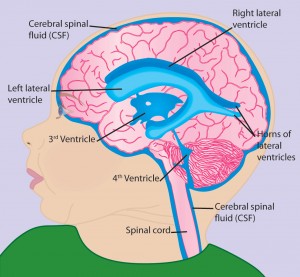Toxicology
Not So Freindly Skies: Another Study Finds Airport Air Pollution Problems
 For the second time in as many weeks, a new study shows dramatic air pollution problems surrounding one of America's major airports. Last week, it was the fact that Particulate Matter was four to five times higher surrounding LAX, adding up to more annual pollution than more than half of the Los Angeles freeway system.
For the second time in as many weeks, a new study shows dramatic air pollution problems surrounding one of America's major airports. Last week, it was the fact that Particulate Matter was four to five times higher surrounding LAX, adding up to more annual pollution than more than half of the Los Angeles freeway system.
This time, it's Logan in Boston, where an epic, 14-year long effort by the Massachusetts Department of Health and Human Services shows that children living adjacent to the airport suffer respiratory problems at levels as much as four times higher than those who live further from from the runways. Adults living nearby are twice as likely to experience chronic obstructive pulmonary disease than their peers living in more distant Boston neighborhoods.
According to the study's authors, the findings are “statistically significant” and take into account pollution from vehicle traffic and socioeconomic factors such as smoking rates and poverty. It's the first research to try to explore specific health effects surrounding an American airport, relying on interviews with more than 6,000 adults, who also provided health information for more than 2,200 children in 17 communities within a 5-mile radius of the airport.and combined them with advanced air modeling data to estimate exposure to airport-related emissions.
In response, Airport officials and city leaders are working on plans to use more hybrid and natural gas-powered vehicles in and around the airport, including maintenance vehicles and rental cars, as well as requiring planes to use only one engine while taxiing.
DFW Airport long ago required electrification of all ground vehicles because of North Texas' chronic smog problems.
Boston's study was prompted by complaints from residents about pollution and health concerns. The 17 communities within the study area were Boston, Brookline, Cambridge, Chelsea, Everett, Hull, Lynn, Malden, Medford, Melrose, Milton, Nahant, Quincy, Revere, Saugus, Somerville, and Winthrop.
Show Me the Money: Putting a Dollar Value on Climate Change
 How do you monetize a human life? How about when that life is impaired with an illness? What's it worth to you not having to rush your child to the emergency room when they're turning blue during an asthma attack? What about to prevent a heart attack?
How do you monetize a human life? How about when that life is impaired with an illness? What's it worth to you not having to rush your child to the emergency room when they're turning blue during an asthma attack? What about to prevent a heart attack?
These days we live in a cost-benefit world that demands this kind of accounting for things that should be accepted at face value. Want to talk about the advantages of cleaner air? You have to be able to put a price tag on it. And, with a small slight of hand, that's what the Obama administration did when it touted all the economic reasons why its new carbon capture rule for existing power plants was a plus for the country.
Carbon pollution itself doesn't directly cause the kind of death and suffering among humans that the Clean Air Act was written to address. Oh sure, it might doom countless species, raise sea levels, and cause global catastrophe, but there's not a way to tie it directly to more mundane respiratory diseases or early mortality that we (well, everyone but the Texas Commission on Environmental Quality) associate with "air pollution."
Instead of pricing catastrophic planetary effects, no matter how self-evident their true costs might be, the EPA instead sought out to tag the out of pocket expenses saved by Americans in cutting pollution associated with carbon, like Particulate Matter and smog. Most of the $55 to $93 billion in economic gains cited by the EPA last week came from these co-benefits, rather than from added spending and jobs in renewable energy or preventing massive crop failures. Otherwise, the new rules might not have been "worth it" from a regulatory point of view. The administration projects the new rules will cause the loss of between 79,900 and 80,400 full-time equivalent jobs in power generation versus 111,800 full-time equivalent jobs in renewable or energy efficiency work, basically a wash.
Want to know the price of an asthma attack? $58. Multiply that by 140,000 to 150,000 across the country and you have the approximately $9 million saved over the next 15 years by reducing soot and smog – a side effect of reducing carbon pollution under the rules.
Non-fatal heart attacks cost an average of $98,000 in health care costs and lost earning power among under-25-year-olds versus an average of $200,000 among 55- to 64-year-olds, because this later demographic is supposedly reaching its peak earning power. Preventing a six-day bronchitis episode is valued at $430.
By far the largest single health impact from the carbon rules seems to come from the forecasted reduction in deaths associated with PM pollution, quickly becoming the most insidious and widespread air pollution threat in the world, and smog. EPA economists estimated savings of between $27.3 billion and $66.7 billion from lower levels of PM 2.5 (fine particles smaller than 2.5 microns in size) and Nitrogen Oxide by preventing 2,700 and 6,600 early deaths.
Most of these numbers come from anticipated cleaner or closed coal plants. It's not unusual for EPA to do accounting this way for the rules it's proposing, although it's the first time it's used it to justify carbon pollution regs.
Will these kinds of arguments win over the skeptics? Doubtful, but that's not who they're aimed at. Instead the administration is using these numbers as talking points to the media and the public in hopes of creating momentum the skeptics can't reverse or rationalize. After all, it's hard for even Rick Perry to call out your child's asthma attacks as unimportant or inconsequential.
Study: LAX Pollutes More Than Half of SoCal Freeways
 Researchers at the Keck School of Medicine and the University of Southern California have just published a report in the American Chemical Society's Environmental Science & Technology journal that shows air traffic from Los Angeles International Airport is responsible for more air pollution than half of all the city's notoriously congested freeways with a plume extending at least 10 miles downwind.
Researchers at the Keck School of Medicine and the University of Southern California have just published a report in the American Chemical Society's Environmental Science & Technology journal that shows air traffic from Los Angeles International Airport is responsible for more air pollution than half of all the city's notoriously congested freeways with a plume extending at least 10 miles downwind.
LAX is the world's sixth largest airport, with 40-60 take-offs an hour. DFW averages 46 according to the airport's own website.
USC Scientists spent a month driving around the LA airport taking air samples for Particulate Mater pollution and found that downwind communities had twice the routine background level of PM in the city. Nine miles out, they found PM levels five times higher than background. Two miles from LAX, PM levels were almost 10 times higher. For comparison's sake, that's equivalent to 174 to 491 miles of freeway traffic. The entire area of Los Angeles County has a total of about 930 miles of freeways. Based on their calculations, scientists concluded that within the area they found to have elevated pollution from the airport, automobiles contributed less than 5 percent of the PN levels. “Therefore, the LAX should be considered one of the most important sources of PN in Los Angeles,” concluded the ACS piece
Why is that a public health concern?
"Ultrafine particles, which form from condensation of hot exhaust vapors, are of particular concern because they deposit deeply into the lungs and can enter the bloodstream. The oxidative stress and resulting inflammation appear to play a role in the development of atherosclerosis (blocked arteries) and can make other health conditions worse, especially for people with existing cardiac or lung conditions including asthma."
As far as we know there's been no study of PM pollution from DFW Airport – no federal highways dollars at stake – but this one from California should prompt one.
Air Pollution is “an overlooked risk factor” for Heart Disease
 Over the last decade we've seen plenty of studies linking air pollution, and specifically Particulate Matter, or soot pollution, to heart disease and attacks. Now Dr. François Reeves,a Canandian cardiologist has a new book "Planet Heart: How an Unhealthy Environment Leads to Heart Disease," that puts those studies in context.
Over the last decade we've seen plenty of studies linking air pollution, and specifically Particulate Matter, or soot pollution, to heart disease and attacks. Now Dr. François Reeves,a Canandian cardiologist has a new book "Planet Heart: How an Unhealthy Environment Leads to Heart Disease," that puts those studies in context.
“You can sum it up like this: more pollution, more major adverse cardiac events. Pollution of the city is as toxic as cigarette smoke. It has different stuff in it, but the difference is that with pollution, you get it all through your life, from your birth to your death. If you live in a polluted milieu, as soon as you’re a baby you’ll take it in through every breath.”
Reeves' interest as a cardiologist in air pollution issues was triggered by a 2008 World Health Organization report that tracked mortality rates for cardiovascular disease in European countries. In nations with relatively clean air like Norway or even France, the levels were approximately 25 to 70 per 100,000 men. In Russia and the Ukraine it was 600-750 per 100,000. “I was blown away by those numbers,” Reeves says. “We know the classical and well-demonstrated risk factors for heart disease, like smoking and obesity and inactivity. But that’s when I realized the environment has a huge impact."
Just like lead, and benzene, and dioxin, and so many other kinds of pollution, there appears to be no "safe level" of exposure to PM pollution. Any amount is capable of doing some harm, and the more you're exposed, the more harm is likely to happen. That's why fence-line communities are particularly vulnerable to higher rates of illness. In DFW, where PM levels are considered under control, there are still lots of hot spots for the pollutant. If you live downwind of the Midlothian cement plants, you're inhaling a lot of soot. the closer you live – Cedar Hill, South Grand Prairie, South Arlington, Mansfield – the more soot you're inhaling.
In his new book Reeves gives a list of heart-healthy things an individual can do to reduce their risk of heart disease, including increased bike riding, more public transit, or walking and weaning yourself off of internal combustion engines with electric cars and hybrids. “Look at everything you’re doing to minimize your footprint and do whatever you can to have an impact on global footprint,” Reeves says,
But he recognizes the limits of this kind of advice if a person is living in a smoggy city or region and offers overarching policy advice for officials. Cities and governments must continue their efforts to be green, if only out of their own self-interest.
If those governments need any convincing, Brauer points to a financial argument: fewer health problems mean less strain on the public system. “If you improve air quality, everybody benefits,” he says. “It’s really, really cost-effective.
Have You Seen This Bucket of Hazardous Waste ?
 It's 2014. Distant parts of the globe are connected within micro seconds. Some of us are driving electric cars. Our phones are more powerful than all the computers it ever took to put a human being on the Moon, combined.
It's 2014. Distant parts of the globe are connected within micro seconds. Some of us are driving electric cars. Our phones are more powerful than all the computers it ever took to put a human being on the Moon, combined.
And we use five gallon buckets from Academy to collect and store industrial hazardous waste.
Or at least the Exide contractors that are in charge of "cleaning-up" Frisco's Stewart Creek do. And they not only use them, they lose them.
On May 8th, workers for Apex-Titan Inc. were collecting battery casing chips and bits of lead slag from fields near the Creek a the intersection of Legacy and Stonebrook and putting them into the bucket. For decades before it closed in 2012, the Exide lead smelter dumped waste into and around the Creek, leaving a still-contaminated trail from the plant site all the way to Lake Lewisiville, approximately five miles away.
After collecting a full load of Exide waste, the contractors placed the bucket in the back of a pick-up truck and drove off – apparently without securing the tailgate first. Despite two staff from the Texas Commission on Environmental Quality on the scene to "document field activities" and the City of Frisco's own contractor present – nine people in all – no one noticed when or how the bucket fell off the truck on he way back to the plant site.
When they discovered the loss, the workers retraced their route. They searched the parking lot of a city park located across the street from a school – one of two in the immediate vicinity. No bucket. More than two weeks later the bucket of hazardous waste is still missing. But we're only now finding out about it.
This would be funny if it weren't for the possibility of this bucket ending up with kids or in a garden or as a water container. As a memo from the City of Frisco puts it:
"We believe it is a reasonable assumption that the bucket was found in the street by a person who picked it up for their own use; without realizing the contents might be hazardous waste."
With that in mind, did the City of Frisco inform the Frisco School District? Did any warnings get issued to students and parents at the two near-by schools? Not as far as we know. Did the City put out an All Points Bulletin for the bucket? No it did not. Embarrassment often keeps officials from doing the right thing about public health. So there's hazardous lead waste out there in a Frisco neighborhood that could be diminishing kids' IQs even as you're reading this, even as officials are too embarrassed to ring the alarm.
Now maybe you're thinking this whole Frisco lead cleanup fiasco now has a new mascot. And you' be right. This bucket pretty much sums up the FUBAR'd state of things. A bankrupt company entrusted to clean-up its own mess. A city council seemingly intent on making sure it ends up with a Superfund Site in the middle of the "second-fastest growing city in America." A state and federal government asleep at the wheel. It's all nicely summed up by that lost five gallon Academy bucket. That's the image. Here's the caption, however, thanks to Jack Fink at Channel 11:
"Mack Borchardt of the city of Frisco said he’s surprised, since they were assured going into this process by Exide that there wouldn’t be any problems with the system in place. “Obviously, that didn’t turn out to be the case,” said Borchardt."
City officials were shocked! Shocked they tell you, that Exide screwed up.
Frisco City officials handed the job over to Exide and expected the same company that ran an outlaw smelter operation to provide an excellent clean-up of their own mess. They had faith! The City is handing over the toxicology and assessment to the state and EPA. They have faith! They're handing the decision about what to do with the waste in Frisco to their lawyers, who are recommending the city host a toxic waste landfill by Stewart Creek in front of the new Grand Park. They have faith! What they don't have is any faith in their own citizenry. After 2 years there's still no transparent, civic dialog on the fate of the thousands of tons of lead waste that remains in the heart of the central business district.
There's no question that given a choice, most Frisco residents would vote to haul the waste completely out of town to a hazardous waste disposal site and develop the property as any other prime piece of real estate. And yet the Frisco City Council is still on course to approve a permanent toxic landfill of its own…… that would be monitored by the same state agency that didn't see that five gallon bucket falling out of the contractor's truck.
What's needed now more than anything else is homegrown vision and leadership. The city needs to take its fate into its own hands instead of entrusting others to look out for its self-interests. There's millions of dollars in state-collected battery fees that are supposed to be going to communities impacted by lead smelting. Frisco certainly qualifies. Instead of arguing with its own residents over a permanent landfill, the Council should be proposing legislation for the next session in Austin to finance a full clean-up.
This incident is a five-gallon splash in the face. Following instead of leading can only result in many future "problems with the system."
We Won a Small Victory – Now Come Take Advantage of It
 This is why citizen participation matters.
This is why citizen participation matters.
Last week, local officials were balking at reserving a slot at next Thursday's regional air planning meeting for a presentation by UNT researchers on how gas industry emissions from the Barnett Shale could be adding to DFW's chronic smog.
After reading about the UNT research in the Denton Record Chronicle, Downwinders at Risk and State Representative Lon Burnam specifically asked the local Council of Governments to include the UNT work on the agenda.
At first, we were told that there was already one technical presentation scheduled for the meeting and there wouldn't be any time for a second.
That struck us as strange, since in the past, every such meeting has always had more than one technical presentation.
When we pointed this out in an e-mail with links to past meeting agendas to prove the point, we quickly got a different response. Suddenly, there would be time for the UNT presentation.
That wasn't so hard was it? All it took was a little logical push back. But if we hadn't supplied it, Thursday would be looking a lot different.
Now, we're asking you to please come and help us push back a little more.
State environmental officials are on record as saying the air pollution from gas mining and production in the Barnett Shale is not adding to DFW's smog.
A lot of us think otherwise.
Come next Thursday, on the 17th, you can listen to the new UNT research on fracking air pollution and ask Texas Commission on Environmental Quality officials directly what makes them so sure that gas pollution isn't hurting local air quality.
Because the format of these regional clean air meetings are now so informal, anyone in the audience can ask questions of a presenter. That means you – if you show up.
It doesn't matter if you don't know the technical lingo. This is all about wind direction, weather, and things that pollute. There are no stupid questions.
The new anti-smog plan that the state is building needs all the public scrutiny it can get. It needs tough examination by people who care about clean air and the truth.
Next Thursday, you can help us put the state on the spot.
This is the first opportunity in 2014 to speak up and sound off about our decades-long smog problem. Don't let the TCEQ leave town without hearing from you.
We fought and won the right for you to listen to this research because we thought it was important. Won't you please come and take advantage of this victory?
We need a good showing to prove DFW residents are still mad about breathing dirty air.
NEXT THURSDAY, APRIL 17th
10 am to 12pm
North Central Texas Council of Government headquarters
616 Six Flags Drive
(After the meeting, State Representative Lon Burnam and Downwinders will be hosting a lunch time de-briefing, location to be decided, so stay tuned.)
Look, we know this is a small victory. But state officials don't want to talk about how gas industry pollution may be making our local smog worse, even though there's evidence that it is.
That's exactly why we think we need to keep bringing it up.
Winning the right to hear a new scientific presentation on the connection between gas pollution and smog may not seem like much of a win, but it is when the Powers-That-Be don't want you to hear it.
We know that small victories like this can lead to larger successes.
In the 1990's the same state agency that's now denying gas pollution has any impact on DFW smog was saying exactly the same thing about the Midlothian cement plants.
It took lots of push back from citizens who knew better before we got the state to admit it was wrong.
Now, Ellis County is in the DFW non-attainment area and the cement plants have controls on them they would otherwise never have.
We need the same effort in 2014 to show the state is as wrong about gas industry pollution as it was about the cement plants.
Right now, Downwinders is the only group committed to organizing citizens around clean air issues in DFW.
But we just lost a funding source that was critical to us and we need your help to keep the pressure on. This money paid for staff work in the field.It's very easy to give securely online here, or you can send checks to our P.O. Box at the bottom of the page.
We really need your help. Thank you.
CDC: Vehicle Exhaust Linked to Higher Child Leukemia Near Roads
 After a review of over 30 years of studies, the Centers for Disease Control concluded that children living near high-volume roads and highways were 50% more likely to suffer from childhood leukemia. The cancer risk is linked to postnatal exposure.
After a review of over 30 years of studies, the Centers for Disease Control concluded that children living near high-volume roads and highways were 50% more likely to suffer from childhood leukemia. The cancer risk is linked to postnatal exposure.
In the April issue of the American Journal of Preventative Medicine, researchers for the CDC explain how they examined all the published studies concerning traffic air pollution risks from 1980 to July of 201. Out of nine relevant studies, seven, covering approximately 8,000 children, reveled a correlation between exposure and leukemia.
"The review found that children diagnosed with leukemia were "50% more likely to live near busy roads than children without leukemia," said Vickie Boothe, a CDC health scientist and lead author of the Journal article. "While the study found a link, it does not prove that living near a busy road causes leukemia."
Previous studies have linked proximity to road traffic with higher childhood asthma and autism rates.
Waxahachie’s Magnablend Settles Lawsuit with Injured Employee
 Once you read the damning testimony of Magnablend's own employees in the Waxahachie Daily Light coverage of the trial, you only wondered how long it would take for the company to settle with James Barron, who claimed the October 3rd explosion and fire at the chemical blending facility had resulted in permanent neurological damage.
Once you read the damning testimony of Magnablend's own employees in the Waxahachie Daily Light coverage of the trial, you only wondered how long it would take for the company to settle with James Barron, who claimed the October 3rd explosion and fire at the chemical blending facility had resulted in permanent neurological damage.
The answer was: one week.
There was one important footnote to pause and ponder. If one reads between the lines of testimony, the implication is the company's new expansion into supplying the fracking industry's chemical needs was behind the 2011 accident, which sent smoke wafting all the way into downtown Dallas.
In cross-examination of company supervisors, it came out that despite Magnablend beginning to manufacture "new blends of chemicals" it was unfamiliar with, the company's on-site chemist wasn't reading the product information that came with the new chemicals. Ventilation in the facility might have been adequate for the kind of chemicals it had historically blended, but it was unable to cope with the build-up of hydrogen that formed when the new batch of chemicals were blended. It's that hydrogen cloud that caused the explosion and fire.
So is Magnablend still blending chemicals for the fracking industry? Is there still a potential for the same kind of accident to occur? if they aren't doing this kind of blending anymore, who is? What facilities are dealing with the same chemicals Magnablend was mixing, and where are they located? Nobody had ever heard of Magnablend before it blew up. Is there another heretofore unknown manufacturer who's taking the same risks without their neighbors knowing it? You can count on it.
Terms of the settlement with Barron were not made public. Magnablend still faces 21 other civil cases arising from the 2011 accident.
FracFocus Fail
 Remember how the gas and oil industry was going to police itself by voluntarily disclosing all those nasty chemicals they put in "fracking fluids" in one easy-to-access-online database? Frac Focus was the 21st Century template for a new level of government-industry cooperation, hailed by Reasonable People everywhere as the answer to getting the truth about what chemicals were really being injected and regurgitated during a frack job. Finally, there would be much needed industry transparency.
Remember how the gas and oil industry was going to police itself by voluntarily disclosing all those nasty chemicals they put in "fracking fluids" in one easy-to-access-online database? Frac Focus was the 21st Century template for a new level of government-industry cooperation, hailed by Reasonable People everywhere as the answer to getting the truth about what chemicals were really being injected and regurgitated during a frack job. Finally, there would be much needed industry transparency.
Turns out. Not so much.
"Oil companies are shielding too much information from public view in an industry-backed database for disclosing chemicals used in oil and gas wells, engineers, environmentalists and energy experts told the Obama administration on Thursday.
The FracFocus registry also contains errors that undermine its role as the leading mechanism for tracking hydraulic fracturing chemicals used in unconventional oil and gas production, said an Energy Department advisory board."
This was no tree-huggers' group making that criticism. It's an advisory board that includes Texas A&M University’s Stephen Holditch, Ram Shenoy with ConocoPhillips, and former Assistant Secretary of Energy Susan Tierney.
As predicted by citizens, the major problem is that companies still want to hide behind the "trade secrets" exemptions and not fully disclose what's in the witches' brew of chemicals they're using.
According to the advisory board, 84 percent of the wells registered in FracFocus invoked a trade secret exemption for at least one chemical since June 1, 2013. In Texas alone, 5,509 of the 6,406 disclosures made in the same time frame invoked a trade secret exception.
So much for transparency. This is exactly why municipalities and states must insist on real full disclosure in their own local ordinances and laws instead of relying on an industry-financed website.
“Another Study Links Air Pollution to Autism” x4
 One of the areas of environmental health research that's producing almost monthly results is the varied and pernicious adverse human health effects of tiny particulate matter, or soot.
One of the areas of environmental health research that's producing almost monthly results is the varied and pernicious adverse human health effects of tiny particulate matter, or soot.
Once only blamed for respiratory problems and then heart attacks, it's now associated with a high blood pressure, strokes, immune system damage and a wide range of neurological diseases and conditions, including IQ loss, Parkinson's, and early dementia. That's because the particles are so small they pass through the lining of the lung and into a person's blood stream and can end up anywhere, including the brain.
Late last week saw the latest study to link PM pollution to autism. It was the fourth major study to do so in the last two years alone. But unlike the previous three, which found an epidemiological association between exposure to PM and the rate of autism in a community, this one may actually begin to explain the physiology of how PM attacks the brain:
"Researchers at the American Association for the Advancement of Sciences (AAAS) annual meeting in Chicago recently detailed the impact that constant exposure to air pollution may have on the developing brain. According to the panel, a series of mouse models have suggested that constant inhalation of air pollution may lead to enlargement of the brain’s ventricles – a hallmark of neurodevelopmental disorders such as schizophrenia and autism."
A brain's ventricular system is a set of four structures containing cerebrospinal fluid (CSF). It's continuous with the central canal of the spinal cord. Cerebrospinal fluid helps to protect the brain, keep it clean and boost its energy. When these ventricles are enlarged, it often indicates a damaged central nervous system. Dr. Deborah Cory-Slechta of the University of Rochester School of Medicine says that's what they found after exposing mice to PM pollution
“When the brain ventricles are too big, it pushes on the rest of the tissue,” Cory-Slectha said. “Also, you have these tracks of what’s called ‘white matter.’ And they cross over the brain; they connect the two hemispheres. And in these mice, those are either missing, or never developed, or died. We don’t know which, but a lot of that is missing, and that too is very characteristic of autism and schizophrenia.”
Ventriculomegaly – the enlargement of the ventricles – is also associated with a range of other brain diseases, such as bipolar disorder and Alzheimer’s disease, as well as a number of birth defects in children. Cory-Slectha noted that this brain damage was largely seen in the male rodents – an interesting finding given that both autism and schizophrenia are mainly male-oriented conditions.
“And part of that that is so interesting is both autism and schizophrenia, not only are they primarily in males, but the rates of those have been going up,” Cory-Slectha said. “And yet nobody can really ever explain why. [They say] it’s the diagnoses, etc. Well you know, air pollution has also gotten worse in some places, and you are exposed to it your entire life. So now we have the [epidemiological research] and we have the animal studies [to support that].”
She's right. We already have very strong correlations between levels of PM pollution and autism that this animal toxicology study now dovetails. Last June, the National Institute of Environmental Health Sciences published a study showing that women living in high air pollution areas while pregnant are up to twice as likely to have a child with autism as those living in less polluted areas.
In March of last year, researches at UCLA published a study showing the more Ozone and Particulate Matter pollution a baby in the womb is exposed to, the more likely he or she will be born with autism. It was the largest study of its kind to date.
In November of 2012, another UCLA study found that children who are born and live their first year closer to major freeways also suffer a significantly elevated risk of autism.
Scientists now know that there is no safe level of exposure to tiny PM pollution, called PM 2.5 because it's 2.5 microns or smaller. Any amount is capable of harming someone, especially if that someone is a child, senior citizen, or already ha health problems. And yet, regulatory agencies pretend this science doesn't exist – otherwise it would be very hard to issue permits for tons of new PM pollution, which they do almost every week.
There's been an explosion in the rate of autism in the US over the last 30 years. Could air pollution account for at least a sizable portion of that increase? The science is saying yes.
